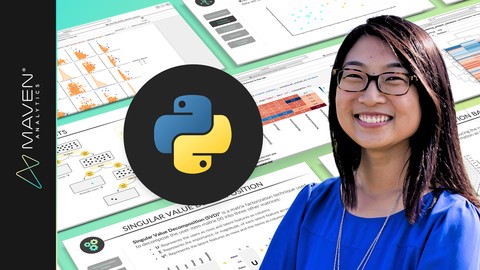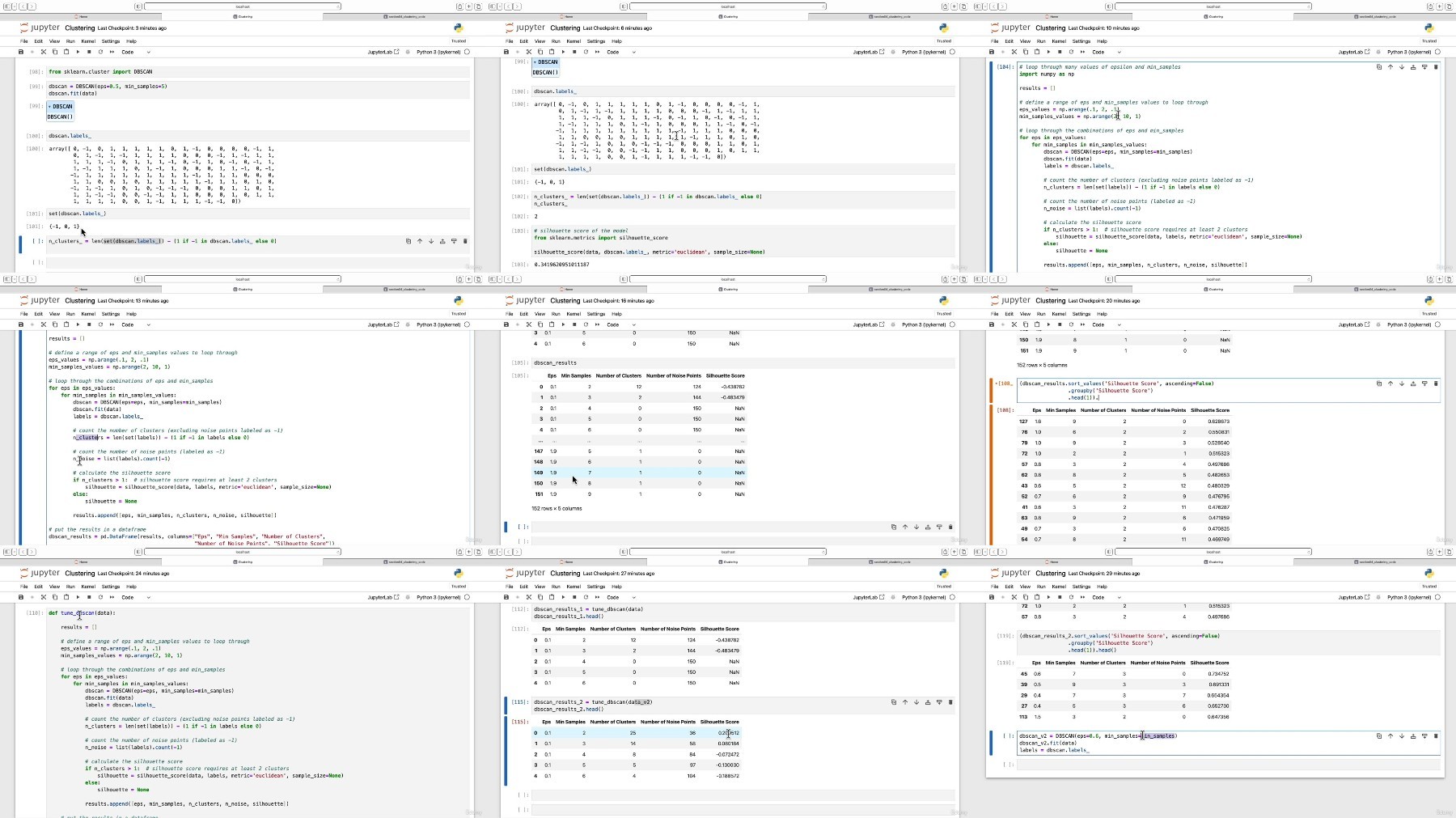Data Science In Python: Unsupervised Learning

Data Science In Python: Unsupervised Learning
Published 4/2024
MP4 | Video: h264, 1920x1080 | Audio: AAC, 44.1 KHz
Language: English
| Size: 5.09 GB[/center]
| Duration: 16h 47m
Learn Python for Data Science & Machine Learning, and build unsupervised learning models with fun, hands-on projects
What you'll learn
Master the foundations of unsupervised Machine Learning in Python, including clustering, anomaly detection, dimensionality reduction, and recommenders
Prepare data for modeling by applying feature engineering, selection, and scaling
Fit, tune, and interpret three types of clustering algorithms: K-Means Clustering, Hierarchical Clustering, and DBSCAN
Use unsupervised learning techniques like Isolation Forests and DBSCAN for anomaly detection
Apply and interpret two types of dimensionality reduction models: Principal Component Analysis (PCA) and t-SNE
Build recommendation engines using content-based and collaborative filtering techniques, including Cosine Similarity and Singular Value Decomposition (SVD)
Requirements
We strongly recommend taking our Data Prep & EDA course before this one
Jupyter Notebooks (free download, we'll walk through the install)
Familiarity with base Python and Pandas is recommended, but not required
Description
This is a hands-on, project-based course designed to help you master the foundations for unsupervised learning in Python.We'll start by reviewing the data science workflow, discussing the techniques & applications of unsupervised learning, and walking through the data prep steps required for modeling. You'll learn how to set the correct row granularity for modeling, apply feature engineering techniques, select relevant features, and scale your data using normalization and standardization.From there we'll fit, tune, and interpret 3 popular clustering models using scikit-learn. We'll start with K-Means Clustering, learn to interpret the output's cluster centers, and use inertia plots to select the right number of clusters. Next, we'll cover Hierarchical Clustering, where we'll use dendrograms to identify clusters and cluster maps to interpret them. Finally, we'll use DBSCAN to detect clusters and noise points and evaluate the models using their silhouette score.We'll also use DBSCAN and Isolation Forests for anomaly detection, a common application of unsupervised learning models for identifying outliers and anomalous patterns. You'll learn to tune and interpret the results of each model and visualize the anomalies using pair plots.Next, we'll introduce the concept of dimensionality reduction, discuss its benefits for data science, and explore the stages in the data science workflow in which it can be applied. We'll then cover two popular techniques: Principal Component Analysis, which is great for both feature extraction and data visualization, and t-SNE, which is ideal for data visualization.Last but not least, we'll introduce recommendation engines, and you'll practice creating both content-based and collaborative filtering recommenders using techniques such as Cosine Similarity and Singular Value Decomposition.Throughout the course you'll play the role of an Associate Data Scientist for the HR Analytics team at a software company trying to increase employee retention. Using the skills you learn throughout the course, you'll use Python to segment the employees, visualize the clusters, and recommend next steps to increase retention.COURSE OUTLINE:Intro to Data ScienceIntroduce the fields of data science and machine learning, review essential skills, and introduce each phase of the data science workflowUnsupervised Learning 101Review the basics of unsupervised learning, including key concepts, types of techniques and applications, and its place in the data science workflowPre-Modeling Data PrepRecap the data prep steps required to apply unsupervised learning models, including restructuring data, engineering & scaling features, and moreClusteringApply three different clustering techniques in Python and learn to interpret their results using metrics, visualizations, and domain expertiseAnomaly DetectionUnderstand where anomaly detection fits in the data science workflow, and apply techniques like Isolation Forests and DBSCAN in PythonDimensionality ReductionUse techniques like Principal Component Analysis (PCA) and t-SNE in Python to reduce the number of features in a data set without losing informationRecommendersRecognize the variety of approaches for creating recommenders, then apply unsupervised learning techniques in Python, including Cosine Similarity and Singular Vector Decomposition (SVD)__________Ready to dive in? Join today and get immediate, LIFETIME access to the following:16.5 hours of high-quality video22 homework assignments7 quizzes3 projectsData Science in Python: Unsupervised Learning ebook (350+ pages)Downloadable project files & solutionsExpert support and Q&A forum30-day Udemy satisfaction guaranteeIf you're an aspiring or seasoned data scientist looking for a practical overview of unsupervised learning techniques in Python with a focus on interpretation, this is the course for you.Happy learning!-Alice Zhao (Python Expert & Data Science Instructor, Maven Analytics)
Overview
Section 1: Getting Started
Lecture 1 Course Introduction
Lecture 2 About This Series
Lecture 3 Course Structure & Outline
Lecture 4 READ ME: Important Notes for New Students
Lecture 5 DOWNLOAD: Course Resources
Lecture 6 Introducing the Course Project
Lecture 7 Setting Expectations
Lecture 8 Jupyter Installation & Launch
Section 2: Intro to Data Science
Lecture 9 Section Introduction
Lecture 10 What is Data Science?
Lecture 11 Data Science Skill Set
Lecture 12 What is Machine Learning?
Lecture 13 Common Machine Learning Algorithms
Lecture 14 Data Science Workflow
Lecture 15 Step 1: Scoping a Project
Lecture 16 Step 2: Gathering Data
Lecture 17 Step 3: Cleaning Data
Lecture 18 Step 4: Exploring Data
Lecture 19 Step 5: Modeling Data
Lecture 20 Step 6: Sharing Insights
Lecture 21 Unsupervised Learning
Lecture 22 Key Takeaways
Section 3: Unsupervised Learning 101
Lecture 23 Section Introduction
Lecture 24 Unsupervised Learning 101
Lecture 25 Unsupervised Learning Techniques
Lecture 26 Unsupervised Learning Applications
Lecture 27 Structure of This Course
Lecture 28 Unsupervised Learning Workflow
Lecture 29 Key Takeaways
Section 4: Pre-Modeling Data Prep
Lecture 30 Section Introduction
Lecture 31 Data Prep for Unsupervised Learning
Lecture 32 Setting the Correct Row Granularity
Lecture 33 DEMO: Group By
Lecture 34 DEMO: Pivot
Lecture 35 ASSIGNMENT: Setting the Correct Row Granularity
Lecture 36 SOLUTION: Setting the Correct Row Granularity
Lecture 37 Preparing Columns for Modeling
Lecture 38 Identifying Missing Data
Lecture 39 Handling Missing Data
Lecture 40 Converting to Numeric
Lecture 41 Converting to DateTime
Lecture 42 Extracting DateTime
Lecture 43 Calculating Based on a Condition
Lecture 44 Dummy Variables
Lecture 45 ASSIGNMENT: Preparing Columns for Modeling
Lecture 46 SOLUTION: Preparing Columns for Modeling
Lecture 47 Feature Engineering
Lecture 48 Feature Engineering During Data Prep
Lecture 49 Applying Calculations
Lecture 50 Binning Values
Lecture 51 Identifying Proxy Variables
Lecture 52 Feature Engineering Tips
Lecture 53 ASSIGNMENT: Feature Engineering
Lecture 54 SOLUTION: Feature Engineering
Lecture 55 Excluding Identifiers From Modeling
Lecture 56 Feature Selection
Lecture 57 ASSIGNMENT: Feature Selection
Lecture 58 SOLUTION: Feature Selection
Lecture 59 Feature Scaling
Lecture 60 Normalization
Lecture 61 Standardization
Lecture 62 ASSIGNMENT: Feature Scaling
Lecture 63 SOLUTION: Feature Scaling
Lecture 64 Key Takeaways
Section 5: Clustering
Lecture 65 Section Introduction
Lecture 66 Clustering Basics
Lecture 67 K-Means Clustering
Lecture 68 K-Means Clustering in Python
Lecture 69 DEMO: K-Means Clustering in Python
Lecture 70 Visualizing K-Means Clustering
Lecture 71 Interpreting K-Means Clustering
Lecture 72 Visualizing Cluster Centers
Lecture 73 ASSIGNMENT: K-Means Clustering
Lecture 74 SOLUTION: K-Means Clustering
Lecture 75 Inertia
Lecture 76 Plotting Inertia in Python
Lecture 77 DEMO: Plotting Inertia in Python
Lecture 78 ASSIGNMENT: Inertia Plot
Lecture 79 SOLUTION: Inertia Plot
Lecture 80 Tuning a K-Means Model
Lecture 81 DEMO: Tuning a K-Means Model
Lecture 82 ASSIGNMENT: Tuning a K-Means Model
Lecture 83 SOLUTION: Tuning a K-Means Model
Lecture 84 Selecting the Best Model
Lecture 85 DEMO: Selecting the Best Model
Lecture 86 ASSIGNMENT: Selecting the Best K-Means Model
Lecture 87 SOLUTION: Selecting the Best K-Means Model
Lecture 88 Hierarchical Clustering
Lecture 89 Dendrograms in Python
Lecture 90 Agglomerative Clustering in Python
Lecture 91 DEMO: Agglomerative Clustering in Python
Lecture 92 Cluster Maps in Python
Lecture 93 DEMO: Cluster Maps in Python
Lecture 94 ASSIGNMENT: Hierarchical Clustering
Lecture 95 SOLUTION: Hierarchical Clustering
Lecture 96 DBSCAN
Lecture 97 DBSCAN in Python
Lecture 98 Silhouette Score
Lecture 99 Silhouette Score in Python
Lecture 100 DEMO: DBSCAN and Silhouette Score in Python
Lecture 101 ASSIGNMENT: DBSCAN
Lecture 102 SOLUTION: DBSCAN
Lecture 103 Comparing Clustering Algorithms
Lecture 104 Clustering Next Steps
Lecture 105 DEMO: Compare Clustering Models
Lecture 106 DEMO: Label Unseen Data
Lecture 107 Key Takeaways
Section 6: PROJECT: Clustering Clients
Lecture 108 Project Overview
Lecture 109 SOLUTION: Data Prep
Lecture 110 SOLUTION: K-Means Clustering
Lecture 111 SOLUTION: Hierarchical Clustering
Lecture 112 SOLUTION: DBSCAN
Lecture 113 SOLUTION: Compare, Recommend and Predict
Section 7: Anomaly Detection
Lecture 114 Section Introduction
Lecture 115 Anomaly Detection Basics
Lecture 116 Anomaly Detection Approaches
Lecture 117 Anomaly Detection Workflow
Lecture 118 Isolation Forests
Lecture 119 Isolation Forests in Python
Lecture 120 Visualizing Anomalies
Lecture 121 Tuning and Interpreting Isolation Forests
Lecture 122 ASSIGNMENT: Isolation Forests
Lecture 123 SOLUTION: Isolation Forests
Lecture 124 DBSCAN for Anomaly Detection
Lecture 125 DBSCAN for Anomaly Detection in Python
Lecture 126 Visualizing DBSCAN Anomalies
Lecture 127 ASSIGNMENT: DBSCAN for Anomaly Detection
Lecture 128 SOLUTION: DBSCAN for Anomaly Detection
Lecture 129 Comparing Anomaly Detection Algorithms
Lecture 130 RECAP: Clustering and Anomaly Detection
Lecture 131 Key Takeaways
Section 8: Dimensionality Reduction
Lecture 132 Section Introduction
Lecture 133 Dimensionality Reduction Basics
Lecture 134 Why Reduce Dimensions?
Lecture 135 Dimensionality Reduction Workflow
Lecture 136 Principal Component Analysis
Lecture 137 Principal Component Analysis in Python
Lecture 138 Explained Variance Ratio
Lecture 139 DEMO: PCA and Explained Variance Ratio in Python
Lecture 140 ASSIGNMENT: Principal Component Analysis
Lecture 141 SOLUTION: Principal Component Analysis
Lecture 142 Interpreting PCA
Lecture 143 DEMO: Interpreting PCA
Lecture 144 ASSIGNMENT: Interpreting PCA
Lecture 145 SOLUTION: Interpreting PCA
Lecture 146 Feature Selection vs Feature Extraction
Lecture 147 PCA Next Steps
Lecture 148 T-SNE
Lecture 149 T-SNE in Python
Lecture 150 ASSIGNMENT: T-SNE
Lecture 151 SOLUTION: T-SNE
Lecture 152 PCA vs t-SNE
Lecture 153 DEMO: Dimensionality Reduction and Clustering
Lecture 154 ASSIGNMENT: T-SNE & K-Means Clustering
Lecture 155 SOLUTION: T-SNE & K-Means Clustering
Lecture 156 Key Takeaways
Section 9: Recommenders
Lecture 157 Section Introduction
Lecture 158 Recommenders Basics
Lecture 159 Content-Based Filtering
Lecture 160 Cosine Similarity
Lecture 161 Cosine Similarity in Python
Lecture 162 Making a Content Based Filtering Recommendation
Lecture 163 ASSIGNMENT: Content-Based Filtering
Lecture 164 SOLUTION: Content-Based Filtering
Lecture 165 Collaborative Filtering
Lecture 166 User-Item Matrix
Lecture 167 ASSIGNMENT: User-Item Matrix
Lecture 168 SOLUTION: User-Item Matrix
Lecture 169 Singular Value Decomposition
Lecture 170 Singular Value Decomposition in Python
Lecture 171 ASSIGNMENT: Singular Value Decomposition
Lecture 172 SOLUTION: Singular Value Decomposition
Lecture 173 Choosing the Number of Components
Lecture 174 DEMO: Choosing the Number of Components
Lecture 175 ASSIGNMENT: Choosing the Number of Components
Lecture 176 SOLUTION: Choosing the Number of Components
Lecture 177 Making a Collaborative Filtering Recommendation
Lecture 178 DEMO: Making a Collaborative Filtering Recommendation
Lecture 179 ASSIGNMENT: Collaborative Filtering
Lecture 180 SOLUTION: Collaborative Filtering
Lecture 181 Recommender Next Steps
Lecture 182 DEMO: Hybrid Approach
Lecture 183 Key Takeaways
Section 10: PROJECT: Recommending Restaurants
Lecture 184 Project Overview
Lecture 185 SOLUTION: Data Prep
Lecture 186 SOLUTION: TruncatedSVD
Lecture 187 SOLUTION: Cosine Similarity
Lecture 188 SOLUTION: Recommendations
Section 11: Unsupervised Learning Review
Lecture 189 Section Introduction
Lecture 190 Unsupervised Learning Flow Chart
Lecture 191 Unsupervised Learning Techniques & Applications
Lecture 192 Unsupervised Learning in the Data Science Workflow
Lecture 193 Key Takeaways
Section 12: Final Project
Lecture 194 Final Project Overview
Lecture 195 SOLUTION: Data Prep & EDA
Lecture 196 SOLUTION: Clustering
Lecture 197 SOLUTION: PCA
Lecture 198 SOLUTION: Clustering (Round 2)
Lecture 199 SOLUTION: PCA (Round 2)
Lecture 200 SOLUTION: EDA on Clusters
Lecture 201 SOLUTION: Recommendations
Section 13: Next Steps
Lecture 202 BONUS LESSON
Data scientists who want to learn how to build and interpret unsupervised learning models in Python,Analysts or BI experts looking to learn about unsupervised learning or transition into a data science role,Anyone interested in learning one of the most popular open source programming languages in the world

https://voltupload.com/pjxe0dewm2a0/Data_Science_in_Python_Unsupervised_Learning.z01
https://voltupload.com/p3z3enkxo41k/Data_Science_in_Python_Unsupervised_Learning.z02
https://voltupload.com/v6ipubz3j3lb/Data_Science_in_Python_Unsupervised_Learning.z03
https://voltupload.com/wikoprjeftit/Data_Science_in_Python_Unsupervised_Learning.z04
https://voltupload.com/j1ghsbjq70k5/Data_Science_in_Python_Unsupervised_Learning.z05
https://voltupload.com/kkpbjnuaaplg/Data_Science_in_Python_Unsupervised_Learning.z06
https://voltupload.com/b43wzmuh1rcx/Data_Science_in_Python_Unsupervised_Learning.zip
https://rapidgator.net/file/06194d16abe956a259e6a65b3c8d567e/Data_Science_in_Python_Unsupervised_Learning.z01
https://rapidgator.net/file/fec6113f65c83ac7015c019140626e45/Data_Science_in_Python_Unsupervised_Learning.z02
https://rapidgator.net/file/c5c19f444e47669aa5099b4afcc1ea45/Data_Science_in_Python_Unsupervised_Learning.z03
https://rapidgator.net/file/d743ff6f10e1b5369fe6aa1ac4489608/Data_Science_in_Python_Unsupervised_Learning.z04
https://rapidgator.net/file/b33f62f0272c6a64fa151804f3c814e8/Data_Science_in_Python_Unsupervised_Learning.z05
https://rapidgator.net/file/08ceb4fbc9bf79c33117846d89499ecd/Data_Science_in_Python_Unsupervised_Learning.z06
https://rapidgator.net/file/5b2d7682437e0f18576d61db0642ccef/Data_Science_in_Python_Unsupervised_Learning.zip
Free search engine download: Data Science in Python Unsupervised Learning
